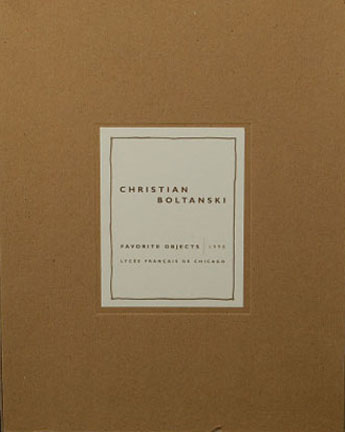About the Photographer
Boltanski, Christian
French, 1944-2021
Christian Boltanski is one of France’s most established contemporary artists. Working with multiple mediums, including installation, artists’ books, and photography, Boltanski’s oeuvre addresses the ephemerality of existence. Among his favorite subjects are childhood, memory, autobiography, loss, and death, with the goal of soliciting a sentimental response from viewers. Boltanski favors photography due to its relationship with time, its ability to serve as a visual representation of memory, and, thus, its power to create emotion. He often employs a documentary aesthetic to exploit photography’s associations with evidence and history. He creates fictional archives to blur the boundary of fact and fiction, all the while drawing on a religious sensibility of relics and shrines.
Favorite Objects (1998), in the collection of the MoCP, is a collaboration between Boltanski and the students of the Lycée Français de Chicago, a private school serving pre-kindergarten through twelfth grade students. As a visiting artist in the Lycée’s Artist-in-Residence program, Boltanski asked each student to bring his or her favorite possession to be photographed. Over the course of two days, the items were uniformly photographed, creating a catalog of mundane yet meaningful objects, ranging from toys to personal journals. Afterward, Boltanski met with students to create artwork related to the photographs, challenging them to explore the significance of their carefully chosen objects. Favorite Objects is the archive of 264 color photocopies created from the original black and white photographs, of which there are 264 editions--the number of students in the school at the time. In addition to holding one of these editions in its permanent collection, the MoCP also houses the original 264 gelatin silver prints on loan from the Lycée.
For Boltanski, who maintains a long-held interest in the loss of childhood, Favorite Objects departs from his usual method of amassing anonymous photographs and items and then displaying them as mysterious shrines or fictional archives out of their original contexts. In Favorite Objects, even commercial toys such as Barbie dolls or Transformers retain an aura of intimacy derived from the knowledge that they were individually chosen by the students. The catalog of objects almost serve as an alternative yearbook, with an object chosen to represent each student, or as a time capsule capturing aspects of the Lycée’s student body in 1998. Despite the assurance that this archive, these objects, and these people are indeed real, questions remain as to what knowledge is gained in viewing the objects as a group and what is revealed about their owners, if anything. In most instances, the mystery remains intact; no more is revealed about these children than the people or objects in one of Boltanski’s fictional archives. The viewer is left to create his or her own narratives. For the students who participated, time may continually transform the archive, permitting it to become saturated with feelings of loss or nostalgia as they become adults.
Christian Boltanski was born in 1944 in Paris, France. He has no formal artistic education. Boltanski participated in Documenta V (1972), VI (1977), and VIII (1987) in Kassel, Germany. He represented France in the 2011 Venice Biennale, as well as participated in the Venice Biennale in 1980, 1993, and 1995. His work has been the subject of major solo exhibitions at the Centre Pompidou, Paris, France (1984); the Museum of Contemporary Art, Chicago, IL (1988); and the Grand Palais in Paris, France, for MONUMENTA 2010. He is the recipient of numerous awards, including the Prix Créateurs Sans Frontiers for visual arts from Culturesfrance (2007); the Praemium Imperiale award by the Japan Art Association (2007); and the Kaiser Ring from the Mönchhaus Museum Goslar, Germany (2001).



